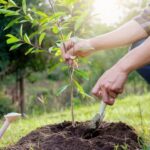Landscaping around trees can not only enhance the visual appeal of your outdoor space but also provide numerous benefits to the health and well-being of your trees. In this article, we will explore various ideas and techniques for creating a beautiful and functional landscape around trees. From choosing the right plants to practical maintenance tips, we will cover everything you need to know to create a stunning tree landscape that complements your overall outdoor design.
When it comes to landscaping around trees, it is essential to consider the unique characteristics of both the tree and its surroundings. By understanding the specific needs and conditions of your landscape, you can make informed decisions about plant selection, maintenance strategies, and aesthetic enhancements.
In the following sections, we will delve into practical considerations such as choosing the right plants, mulching and edging techniques, budget-friendly ideas, and seasonal maintenance. Whether you are a seasoned gardener or new to landscaping, this article will provide valuable insights into maximizing the beauty and health of your tree landscape.
Assessing the Tree and Its Surroundings
When it comes to landscaping around trees, it’s crucial to start by assessing the tree and its surroundings. Understanding the landscape is essential for determining the best approach to take when designing and maintaining a tree’s ecosystem. One of the first things to consider is the type of tree you have and its specific needs. Different trees require different care, so it’s important to research your tree species before choosing plants and design elements for your landscape.
Another important aspect of assessing your tree and its surroundings is understanding the soil and sunlight conditions in the area. Some plants may not thrive if they are planted in soil that doesn’t meet their needs, while others may require full sun or partial shade. By understanding these environmental factors, you can choose the right plants that will complement your tree and enhance the overall landscape.
In addition to the natural factors, it’s also important to consider any existing structures or features near your tree that could impact your landscaping plans. This includes things like fences, walkways, or neighboring trees and shrubs. Taking stock of these elements will help you create a cohesive design that works with what you already have in place.
| Aspect to Consider | Consideration |
|---|---|
| Type of Tree | Different trees require different care. |
| Soil and Sunlight Conditions | Choose plants that meet soil and sunlight needs. |
| Existing Structures or Features | Fences, walkways, neighboring trees can impact landscaping. |
Choosing the Right Plants
Factors to Consider
Before choosing plants to surround your trees, it’s important to assess the specific conditions of your landscape. Factors such as the shade and root competition from the tree, soil acidity, and moisture levels will all influence which plants will thrive in that environment. Additionally, consider the mature size of the chosen plant and ensure it has enough space to grow without competing with the tree or becoming overcrowded.
Best Plant Options
For shaded areas around trees, consider planting shade-loving perennials such as hostas, ferns, or coral bells. These plants are well-suited for low light conditions and can add texture and color to the base of your tree. Ground covers like vinca or creeping phlox are also excellent options for filling in bare spots and providing visual interest.
Using native plants can also enhance your tree landscape as they are well-adapted to the local climate and soil conditions. Native grasses and wildflowers not only provide natural beauty but also support local wildlife by providing food and shelter. Additionally, incorporating a mix of flowering plants such as impatiens or begonias can add seasonal color to your tree landscape.
Choosing the right plants for landscaping around trees involves careful consideration of various factors such as sunlight exposure, soil type, and space limitations. By selecting shade-loving perennials, ground covers, native plants, and flowering annuals, you can create a diverse and visually appealing landscape while supporting a healthy ecosystem. With these plant options in mind, enhancing the beauty of your tree landscape is within reach.
Mulching and Edging
One of the most important aspects of landscaping around trees is maintaining their health and vitality. Mulching and edging are practical ways to achieve this, as they can help control weeds, retain moisture, and protect the tree’s roots from lawnmower damage.
When it comes to mulching around trees, it’s essential to choose the right type of material. Organic mulches like wood chips, bark, or compost are excellent options as they decompose over time, adding nutrients to the soil. Inorganic mulches like rocks or rubber mulch can also be used for a more decorative look. However, it’s important to avoid piling mulch directly against the tree trunk as this can create excess moisture and promote rot.
In addition to mulching, edging is another important aspect of maintaining healthy trees in your landscape. Edging helps define the area around the tree and prevents grass and weeds from encroaching on the root zone. This not only improves the appearance of your landscape but also reduces competition for water and nutrients. Consider using metal, plastic, or stone edging to create a clean separation between the tree and surrounding plants or grass.
| Mulching Tips | Edging Tips |
|---|---|
| Choose organic materials for mulching | Use metal, plastic, or stone edging |
| Avoid piling mulch against tree trunks | Create a clean separation between tree and surrounding plants or grass |
Creating Visual Interest
When it comes to landscaping around trees, there are several ways to create visual interest and add aesthetic appeal to your outdoor space. By carefully selecting the right plants, incorporating attractive mulching and edging, and adding personal touches, you can transform the area around your trees into a beautiful and inviting landscape. Here are some ideas for enhancing the visual appeal of your tree landscape:
- Choose a variety of plants: Select a mix of flowers, shrubs, and ground cover plants that complement the size and shape of your trees. Consider planting perennial flowers such as hostas or ferns for added texture and color throughout the growing season.
- Incorporate decorative mulch: Define the space around your trees with a layer of decorative mulch such as wood chips or pine straw. This not only adds a polished look to your landscape but also helps retain moisture in the soil and suppress weed growth.
- Add natural stone edging: Create defined borders around the base of your trees with natural stone or pavers. This not only adds visual interest but also provides a clean edge for mowing and maintenance.
In addition to these suggestions, consider adding personal touches such as garden ornaments, bird feeders, or stepping stones to further enhance the aesthetic appeal of your tree landscape. By taking these practical steps, you can create a visually appealing outdoor space that complements the natural beauty of your trees while adding value to your property.
Start planning now and breathe life into this project.
Practical Considerations
Landscaping around trees can be a great way to enhance the beauty of your outdoor space while also providing practical benefits to the health of your trees. However, it’s important to consider budget-friendly ideas when planning your tree landscaping project. By being mindful of your spending, you can create a stunning and sustainable landscape that doesn’t break the bank.
DIY Projects and Upcycling
One of the most budget-friendly ideas for landscaping around trees is to take on some DIY projects and upcycle materials. For example, creating your own mulch from fallen leaves or using old pallets to construct raised plant beds can add character to your landscape without costing a fortune. Additionally, upcycling old items such as wooden crates or barrels as planters can give your tree landscape a unique and creative touch.
Native Plants and Seeds
Another cost-effective approach to landscaping around trees is to opt for native plants and seeds. Native plants are well-suited to the local climate and soil conditions, often requiring less maintenance and watering compared to non-native species. By choosing native plants and starting from seeds instead of fully-grown plants, you can save money while promoting biodiversity in your tree landscape.
Community Sharing and Swapping
Consider reaching out to your local community for plant sharing or swapping opportunities. Many gardening enthusiasts are willing to share cuttings or divisions from their existing plants, allowing you to diversify your tree landscape without spending much money. Joining community gardening groups or attending plant swap events can provide access to a wide variety of plants for little to no cost, making it an affordable way to enhance the greenery around your trees.
By implementing these budget-friendly ideas for landscaping around trees, you can create an attractive and sustainable outdoor space without overspending. With a little creativity and resourcefulness, you can achieve a beautiful tree landscape that enhances the overall look of your property while also nurturing the health of your trees.
Seasonal Changes
When planning your landscaping around trees, it’s important to consider how the space will change throughout the year. Different seasons bring different challenges and opportunities, so it’s essential to have a plan for maintaining your tree landscape year-round.
One way to ensure your tree landscape looks great in every season is to choose a variety of plants that offer interest throughout the year. Evergreen shrubs and perennials can provide color and texture even in the winter months when deciduous trees have lost their leaves. In the spring and summer, flowering plants can add bursts of color, while in the fall, you can incorporate plants with beautiful foliage that complements the changing colors of the trees.
In addition to selecting the right plants, it’s important to regularly maintain your tree landscape as the seasons change. This includes tasks such as pruning, weeding, and refreshing mulch. By staying on top of maintenance throughout the year, you can ensure that your tree landscape remains healthy and visually appealing in every season.
Final Touches
Adding personal touches to your tree landscape is a great way to make it unique and reflective of your personality. There are various ways to add personal touches to your tree landscaping, from customizing the types of plants you use to incorporating decorative elements that hold sentimental value.
Here are some ideas for adding personal touches to your tree landscape:
- Customized plant selection: Choose plants and flowers that have personal meaning to you, such as your favorite flowers or plants with significant symbolism.
- Decorative elements: Adding decorative elements around the base of the tree can further personalize your landscape. Consider incorporating items like personalized stepping stones, decorative garden statues, or even handmade planters.
- Outdoor seating area: If space allows, consider creating a cozy seating area around the tree where you can relax and enjoy the natural beauty of your landscape.
Incorporating these personal touches will not only enhance the aesthetic appeal of your tree landscape but also create a space that reflects your individual style and preferences. By customizing your landscaping around trees, you can create a truly unique outdoor space that brings joy and relaxation to both you and others who visit.
Conclusion
In conclusion, landscaping around trees not only adds beauty and aesthetic appeal to your outdoor space but also plays a crucial role in maintaining the health and well-being of your trees. By carefully assessing the tree and its surroundings, choosing the right plants, and implementing practical maintenance tips such as mulching and edging, you can create a visually stunning and healthy landscape that enhances the natural beauty of the trees.
Furthermore, by considering practical considerations and budget-friendly ideas for landscaping around trees, you can achieve a beautiful landscape without breaking the bank. Whether it’s incorporating seasonal changes or adding personal touches to your tree landscape, there are plenty of opportunities to get creative and make your outdoor space truly unique.
Ultimately, embracing the beauty of landscaping around trees allows you to create a welcoming and visually appealing outdoor environment that not only enhances the beauty of your trees but also provides a peaceful and serene atmosphere for you and your visitors to enjoy. With careful planning, attention to detail, and creativity, your tree landscape can be transformed into a breathtaking oasis that adds value to your property and brings joy for years to come.
Frequently Asked Questions
What Is the Best Way to Landscape Around Trees?
The best way to landscape around trees is to create a “mulch ring” around the base of the tree, which helps retain moisture and prevent damage from mowers and trimmers. Adding some smaller plants or flowers around the base can also enhance the overall look while still allowing the tree to be the focal point.
How Do I Landscape My Backyard With Trees?
When landscaping a backyard with trees, it’s important to consider the size and placement of the trees in relation to other elements such as garden beds, pathways, and seating areas. Incorporating a variety of plantings beneath the trees can add visual interest and complement their natural beauty.
What Is the Best Material to Put Around a Tree?
The best material to put around a tree is organic mulch, such as wood chips or shredded bark. This type of mulch allows for proper air circulation, retains moisture, and provides nutrients as it breaks down over time.
It’s important to avoid using plastic or rubber mulch which can prevent water and air from reaching the roots of the tree.

Welcome to my gardening blog! I am passionate about plants and enjoy sharing my knowledge and experiences with others. In this blog, I will write about everything related to gardening, from tips on how to get started to updates on my own garden projects.





